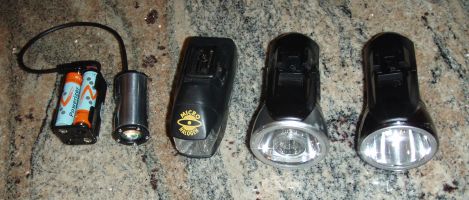
AA batteries are convenient to carry and easy to find at many stores. In this class of lights, the battery compartment tends to dictate the overall shape and size of the light. The choice of 4-AAs results in convenient all-in-one packaging.
I've decided to compare four lights of this type (that I own) under reasonably controlled conditions. As stated above, weight-wise and overall size-wise, they're all about the same.
[For the record, I own many more bicycle lights of different types and cost levels, including a 10W HID and quite a variety of halogen and LED lights of different wattages. However, none of the other lights I own work on 4-AAs.]

From left to right:

|
I positioned three objects of interest:
I would characterize the two closer objects as being "nearfield" in the sense that we react relatively instinctively and immediately to them in terms of steering input. The furthest object (and beyond) I would say are "distant" in the sense that we can recognize and plan for those objects but we do not need to process them immediately. |
So how do they compare? Beam patterns are shown below.
[Link to dpreview.com elements here. Adjust your monitor. You should be able to distinguish between A, B and C, and also X, Y and Z.]
From left to right:
An Olympus 720SW point-and-shoot mounted on a tripod was used for this series. Except for the scene picture, each one was exposed at shutter speed: 0.5s, F3.5, and 250 ISO.
Basically, I decided to adjust the angle of each light to (subjectively) place its brightest spot just in front of the water bottle that was placed at a distance 26 ft.
In actual use, I employ more than one of these lights. One positioned one to illuminate strongest at around 24 ft and another one much further down the road (basically at infinity).
For brevet use, there is a two light minimum for this category of lighting. I've used two Cateye Micros (one nearfield and one for distance). A helmet light is really also necessary for street signage illumination. The DiNotte 5W can improve on this as long as it is supplemented by an instant-on light that can serve to illuminate deep into a descent. However, I am not yet sure how long the DiNotte 5W will last on a set of AA lithiums.
Sandiway Fong